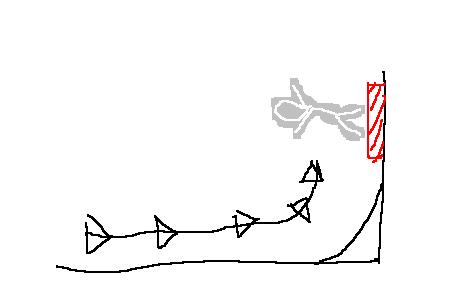Stacking problems makes for more interesting puzzles
I know I said I’d be making a decent introduction to my game saying what it’s about and stuff, but I’ll leave that for another day as I’d rather talk about what I’ve done today, and the thinking behind it.

A new level I made today, just for you... well really I made it for me but I'm in the mood for sharing so you are lucky 🙂
In this post I’ll be going into detail about a new level I made, so if you dont want ‘puzzle spoilers’ (if such a thing exists) then you can play here before reading.
this level was made as a quick test for a feature I coded today of what I call a ‘drain field’; when Sarah passes through it, she can’t use her wall running powers until she reaches a recharge point.
Why I made these new ‘drain field’ things:
this is a similarish use to what I originally had in mind for recharge points, Sarah would only have so many ‘uses’ of her wall-running before having to return to a charge point to refil them. after a little testing it turned out this created very few extra possibilities for gameplay, and mostly meant 400% (figure may be a guess) more backtracking, so this was ditched in favour of a ‘limited time’ power, so I can have walls that take longer than the timer allows to traverse, causing sarah to fall off the wall unless she can make it to a recharge point and max out her wall-running timer.
This worked out pretty well, but resulted in very few possible situations where a recharge point was actually neccesary, and I did like how not being able to use your ability before getting to a recharge point forced a certain type of traditional platforming, essentially changing the way the player has to see the level until they are ready to run along walls again.
Complex problems are just sevral simple ones bundled together:
And thus, the drain field was born. I like it particularly because it lends itself very well to how I design puzzles; any problem is simple on its own, but when sevral simple problems are combined it makes for a more complex one where the player is best off standing back and trying to figure bits out step by step. heres an explanation of how this works in todays level:
simple problem #1:
simple solution #1:
and we can make this ‘puzzle’ more complex by adding another problem, specifically the problem being the removal of the solution.
simple problem #2:
so the solution is to find a way use your power, in this level you must do some platforming to cross the field and find a recharge point, but I could just as easily force platforming and have a gap in the field to navigate to, or some button puzzle to turn off the field etc, all possible solutions to the problem I will explore as I plan my levels.
The Point is…
the point, which I’m probably not being all too clear about, is that with a wider range of simple problems to choose from, the combination of these different problems can create a vast range of potential complex problems, and keep the game both interesting and challenging.
also, it’s my hope by forcing the player to navigate without using wall running powers I’ll be able to make parts of my levels contain more traditional platforming with bouncy, slippery and moving surfaces I had (and quite enjoyed) in my early builds but not so much since adding the wall running power.
what do you think of my approach to puzzle design, is it a little too simple, as all the puzzles can be potentially solved by deciding where you want to end and work backwards step by step, or is that the perfect way to have to solve a puzzle? any suggestiong for alternatives?



